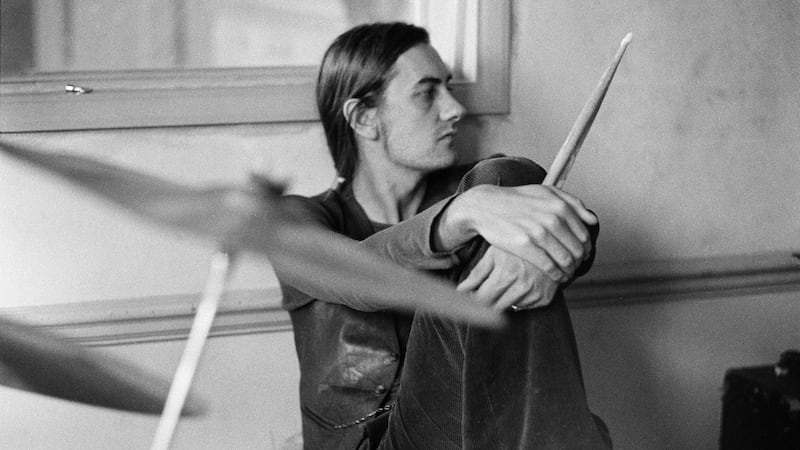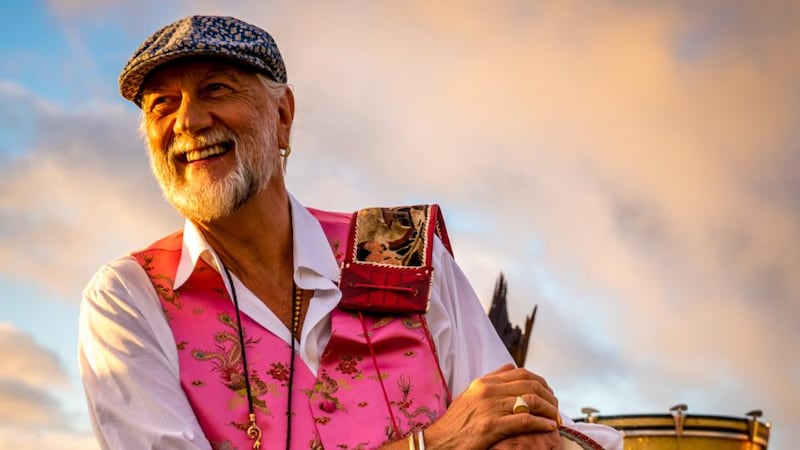Before being introduced to Mick Fleetwood on the top floor of a downtown hotel in Austin, Texas, I’m reminded by his publicist that the 70-year-old drummer’s new book focuses on the band’s early years (“Peter Green’s Fleetwood Mac”, as it was sometimes known).
The band's legendary period, though – which later involved Lindsey Buckingham and Stevie Nicks and led to the stone cold classics of Fleetwood Mac and Rumours – is difficult to ignore.
The band’s penchant for cocaine, LSD and in-house extramarital relations – along with the classic lineups with Green followed by Buckingham, Nicks, Fleetwood, and Christine and John McVie – has, for many, crystallised the band’s identity.
The day before we meet, Fleetwood has been to see Stevie Nicks perform at the Frank Irwin Centre in downtown Austin. "She was great," he says. "She did a lot of storytelling and even told the crowd to prepare themselves because she was going to be talking a lot more than she's normally allowed to in Fleetwood Mac."
The band turns 50 this year, with no signs of giving up. The publication of Love That Burns, the first in what will surely be a series, in the same year is merely coincidence, says Fleetwood. "We've been working on an idea like this for a while now and it's just luck that we finally got it together this year."
Diehard fans only
This, though, is one for diehard fans only. The 300-page “collector’s item” costs £325 and is filled with previously unseen photos. Only 2,000 copies are being made, with Fleetwood signing each one.
The book begins as autobiography, with many pages devoted to Fleetwood’s upbringing, part of which was spent in Norway and Egypt on account of his father’s position in the RAF. Fleetwood’s father, himself a keen drummer, encouraged his son’s interest in music, and, when he was 15, his parents reluctantly agreed to let him drop out of school to focus on music professionally. In 1963 he moved in with his older sister in London and began playing anywhere and with whomever he could.
Peter could have been the stereotypical superstar guitar player and control freak, but that wasn't his style. He named the band after the bass player and drummer, for Christ's sake
The British blues explosion of the late 1960s was in full swing and Peter Green recruited Fleetwood to play with John Mayall and the Bluesbreakers. Green had replaced Eric Clapton on guitar and was the rising star of the scene. He decided it was time to go his own way, but not without first poaching Fleetwood and later bassist John McVie from Mayall's lineup.
Forever shying away from the limelight, it was Green who suggested naming the band after the rhythm section. But this, according to the book, was just one example of his generosity as a musician.
"Peter could have been the stereotypical superstar guitar player and control freak," Fleetwood says. "But that wasn't his style. He named the band after the bass player and drummer, for Christ's sake. He was also always willing to give as much space and creative freedom to other members, like guitarist Jeremy Spencer, and songwriter Danny Kirwan, at the expense of his own creativity."

Sense of confidence
Fleetwood attributes a lot of credit to Green for instilling in him a sense of confidence in his playing. “I’ve never been a technical player. I’ve always had quite a light touch and Peter was the first person to ever say, that’s okay. He made me believe in my style of playing, which really suited the blues we were so into at that time anyway.”
Both Fleetwood and longtime bassist John McVie subscribe to the “less is more” school of thought for drums and bass. “The rhythm section is there to serve,” he says. “John and I have always felt very strongly about that. It’s not about showing off. We’re there to support the front line so they can bounce around all over the place while we keep it cool.”
Major successes with songs such as Black Magic Woman, Albatross, Man of the World and Oh Well meant that by 1969 the band was enjoying significant success in the UK and on mainland Europe under Green's tutelage. However, the lead singer and songwriter wasn't that enamoured by the spotlight.
“It’s already public knowledge that he was taking a lot of acid and mescaline around the same time his illness began manifesting itself more and more,” says Fleetwood. “We were oblivious as to what schizophrenia was back in those days but we knew something was amiss.”
Hearing voices
Green began hearing voices and became increasingly paranoid.
"We might not have known it then but you can clearly hear his anguish in the lyrics of later songs such as The Green Manalishi (With the Two Prong Crown)."
When Green announced his decision to leave the band in 1970, the others were understandably devastated.
I've always believed you should accept musicians for what they are. That's why Fleetwood Mac became so many different things over the years.
“When the unexpected happens you either run for the hills or, if you’ve got your head screwed on, you work with what you have left. There was definitely an element of fear and sadness when Peter left but also the realisation that we had to get our shit together or else we’d all be f**ked.”
Without Green, though, there would of course never have been a band at all. "For his legacy I think it's important we remember that Fleetwood Mac was, first and foremost, a blues band. We all played and loved blues. And long after Peter left, we went to Chess Records in Chicago where we recorded with Willie Dixon and Buddy Guy. Can you imagine how that made us feel? Such an incredible experience could not have happened without Peter because, even though he wasn't with us, the reason there's a Fleetwood Mac at all is because of him."
Peter Green continued making music after leaving Fleetwood Mac, initially with his old bandmate John Mayall. Over the years he recorded sessions with a variety of musicians, including BB King in 1972. While mental illness and drug abuse made it difficult for Green to stay focused on music, in the late 1990s he formed the Peter Green Splinter Group which went on to release nine albums between 1997 and 2004. In 1998 he was inducted into the Rock and Roll Hall of Fame.

Tragic figure
It clearly irks Fleetwood that many incorrectly assume Green is seen as some tragic figure, 20 feet from stardom before the rug was ripped from under him. The reality for Fleetwood is that he was lucky enough to experience fame and success twice with the same band. “People still say to me, ‘Isn’t it sad how Green started the band but didn’t enjoy get to enjoy its success?’ That’s not true. It may have been a different world to what we enjoy now but we all discovered what success felt like back in the 1960s. We had number one hits in England and across Europe and Peter, while maybe not necessarily enjoying his new-found fame, certainly experienced it.”
Green’s departure left a significant vacuum in the band, leading both Fleetwood and McVie to take refuge in family life. It was here they discovered the answer to their problems had been right in front of them all along. McVie’s wife Christine had given up her music career to marry him, having previously been a well-known musician in her own right. She joined Fleetwood Mac two days before they embarked on a US tour, and the rest is history.
The story of Fleetwood Mac isn't over but, without getting too serious, I am 70 years old. This can't go on forever
While the direction the music took following the departure of Green might suggest otherwise, the group’s founding father still managed to leave an unconventional yet lasting impact on the approach Fleetwood and co took in terms of bringing on new members.
“Some bands, like AC/DC, have lost members and replaced them with someone who is almost a duplicate of their predecessor,” says Fleetwood. “Perhaps because I’m not a writer or lead player myself, I’ve always believed you should accept musicians for what they are. That’s why Fleetwood Mac became so many different things over the years.”
Glimpses of genius
Fleetwood says he could see glimpses of the same genius Peter Green had when he first saw Lindsey Buckingham perform.
“They had the same essence but with very different forms of expression. In both I recognised that quality in artists who have mastered their instrument to such an extent that they begin to create a sound unique only to them.
“Peter was a very generous musician who was always willing to take a step back and let others realise their own creative vision. I have always believed in this approach and try to have faith in the artistic vision of any new musicians and writers I work with. This is what has allowed Fleetwood Mac to become so many different things.”
After several years of infighting, Christine McVie’s decision to rejoin in 2014 after quitting in 1998 was met with jubilation by the band’s fans around the world. The full five-piece outfit, most of whom are now in their 60s and 70s, were on the road for the first time in 16 years. Their On With The Show world tour in 2014-2015 was a commercial and critical hit, making just under $200 million.

Scheduled to tour
The band are scheduled to tour again in 2018, and Christine McVie and Lindsey Buckingham are working on a new album, that also features Mick Fleetwood and John McVie, though it will not go out under the Fleetwood Mac name. In recent interviews, Nicks says she is reluctant to record another album.
"I don't think we'll do another record," she told Rolling Stone. "If the music business were different, I might feel different. I don't think there's any reason to spend a year and an amazing amount of money on a record that, even if it has great things, isn't going to sell."
Mick Fleetwood is a little more sanguine. “The story of Fleetwood Mac isn’t over but, without getting too serious, I am 70 years old. This can’t go on forever, which is why I think it’s important to leave behind lovely things that chronicle those moments in life that one is most proud of.”
Love That Burns: A Chronicle of Fleetwood Mac Volume One 1967-1974 will be published by Genesis Publications in September. Copies can be pre-ordered. See genesis-publications.com

















